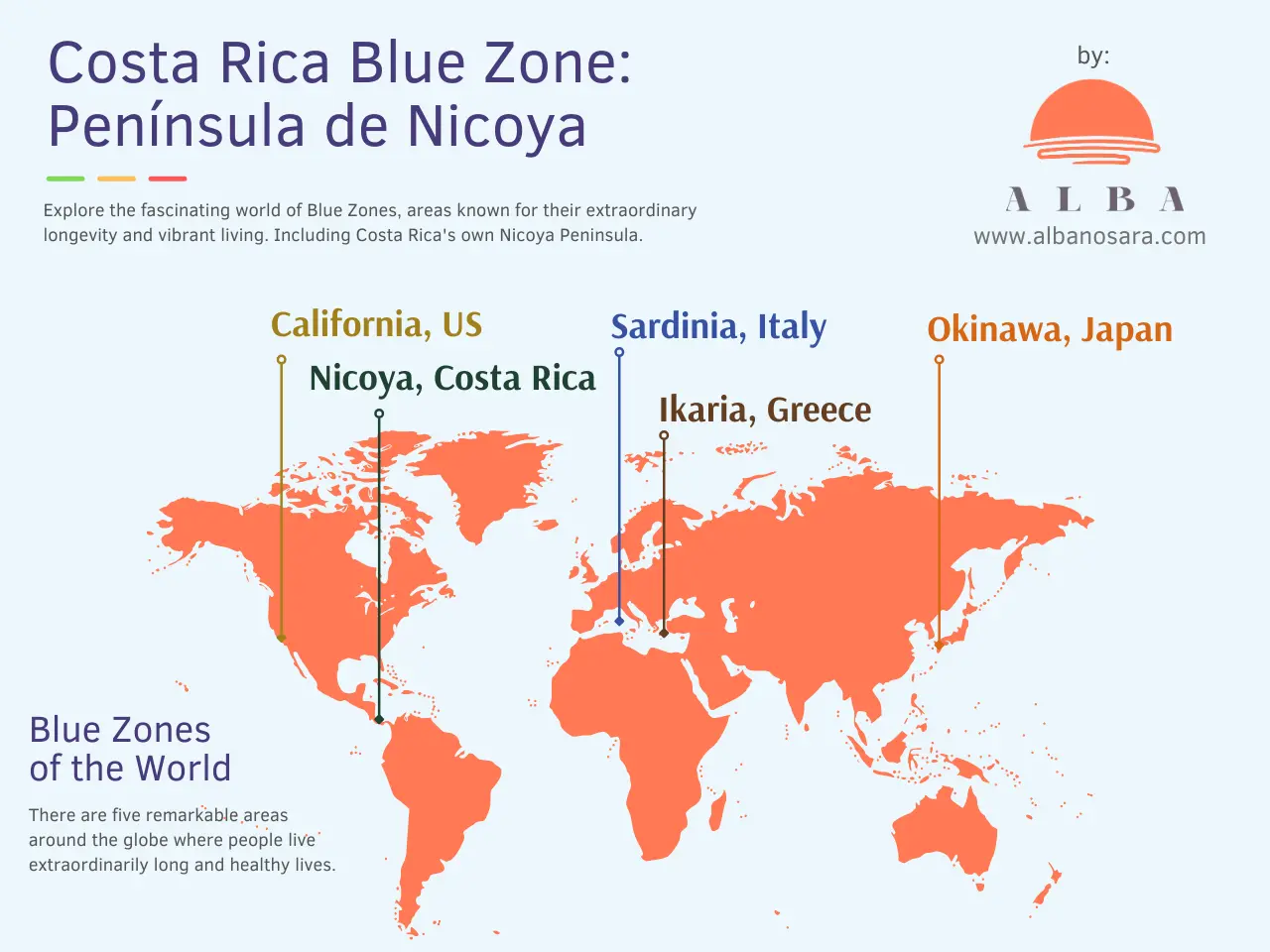
Close

Costa Rica’s Blue Zone is located in Nicoya part of Guanacaste Province – a northwestern serene and picturesque region with 207,000 inhabitants – is considered one of a handful of global “blue zones,” a label coined to designate hotspots of extraordinarily high longevity.
Nicoya canton is subdivided in 7 districts and one of them is Nosara, also home to Alba Properties & Property Management located in the famous Playa Guiones and their array of vacation rentals in Nosara.
For those journeying from afar, whether from the USA, Canada, or Europe, the most convenient gateway to this oasis of wellness is through the Daniel Oduber International Airport in Liberia (Airport Code: LIR). Alternatively, visitors can also fly into Juan Santamaría International Airport (Airport Code: SJO) and embark on a scenic drive to Guanacaste.
Delving into the heart of this Blue Zone, a study by Madrigal-Leer, F., Martìnez-Montandòn, A., Solìs-Umaña, M. et al., published in Aging Clinical and Experimental Research (2020), offers a profound insight into the unique characteristics of the Nicoya Peninsula’s centenarians.
Despite Costa Rica being a medium-income country, it boasts an impressive average life expectancy of 80.2 years, the third highest in the Americas. The study highlights an unusual concentration of centenarians in Nicoya, with a ratio of 1:4322 compared to 1:7541 in the rest of Costa Rica.
This discovery led to the designation of the Nicoya Peninsula as a Blue Zone, a term symbolizing areas with exceptionally high longevity rates.
The Nicoya Peninsula, composed of five municipalities: Santa Cruz, Carrillo, Nicoya, Nandayure, and Hojancha, stands out with its 183,184 inhabitants. The 2020 study conducted a comprehensive geriatric assessment on 43 community-dwelling centenarians, revealing a mean age of 101.93 years.
It found significant gender differences in health and dependency, along with a high prevalence of malnutrition, hypertension, low Vitamin D levels, and visual impairment.
Despite these challenges, the centenarians showed lower rates of diabetes, depression, ischemic heart disease, and chronic obstructive pulmonary disease, offering a glimpse into their unique health profile.

Many of us dream of living a long, healthy life, perhaps reaching our 90s without battling chronic diseases.
But what if this isn’t just wishful thinking? According to a comprehensive study led by Dan Buettner, BA, and Sam Skemp, BA, and first published online on July 7, 2016, titled “Blue Zones: Lessons From the World’s Longest Lived”, this dream could be closer to reality than we think.
Their research unveiled a startling truth: only about 20% of how long the average person lives is determined by genetics. The remaining 80%? It’s all down to our lifestyle.
Buettner and his team identified five specific areas worldwide with the highest number of centenarians – people who live to or beyond the age of 100.
These areas, christened as “Blue Zones,” were pinpointed using a combination of epidemiological data, statistical analysis, birth certificates, and meticulous research.
Remarkably, these zones show rates of centenarians that are 10 times greater than those in the United States.
To understand the secrets of these zones, a specialized team comprising anthropologists, demographers, epidemiologists, and researchers delved deep into the lifestyles of the residents.
What they discovered was fascinating: regardless of their geographical location, the lifestyles of all Blue Zone inhabitants shared nine specific characteristics, aptly named the “Power 9.”
These characteristics aren’t just incidental; they form the backbone of a lifestyle that fosters longevity, health, and happiness.
In his groundbreaking study, Dan Buettner and his team identified five remarkable areas around the globe where people live extraordinarily long and healthy lives. These Blue Zones are:
Each of these zones not only boasts a high percentage of centenarians but also offers invaluable insights into living a long and fulfilling life.
At the heart of their longevity are the “Power 9” principles, nine lifestyle habits that are common across these diverse regions.
These aren’t complex medical interventions but simple, everyday practices that anyone can incorporate into their lives:

These principles, backed by extensive research, provide a blueprint for not just living longer, but living better. They emphasize that longevity isn’t just about genetics or medical advancements, but about a lifestyle that nurtures the body, mind, and soul.
Complementing this scientific perspective, a 5-minute YouTube video by the Today Show, titled “TODAY Visits ‘Blue Zone’ Of Costa Rica Where People Live To 100”.
This piece, featuring NBC News special anchor Maria Shriver and Blue Zones concept creator Dan Buettner, showcases their visit to the region.
They met with José Bonifacio “Pachito” Villegas, a centenarian from Pochote de Quebrada Honda, Nicoya, providing viewers with a vivid and personal look into the daily lives of these remarkable individuals.
The Nicoya Peninsula’s Blue Zone status is not just a testament to the longevity of its residents but also a beacon of hope and inspiration.
It underscores the power of lifestyle, community, and environment in shaping our health and wellbeing, offering valuable lessons for a life well-lived.
If you still interested in learning more about the blue zones, Albanosara.com suggest to watch: “Live to 100: Secrets of the Blue Zones,” a 2023 Netflix documentary series hosted by Dan Buettner, takes viewers on a global journey across five Blue Zones – Okinawa, Sardinia, California, Ikaria, and the Nicoya Peninsula.
Each episode explores the unique lifestyles and traditions that foster longevity in these regions, from Japan’s purposeful living to the distinct diets in Greece and Costa Rica, and even examines the potential for new Blue Zones in Singapore and the U.S.
This series is essential viewing for those curious about the secrets of living a long, healthy life.
Alba Properties Nosara
Calle Guiones, Café de Paris, next to Harmony Hotel, 2nd floor C21 Guiones, Nosara, Guanacaste – Costa Rica 50206
© 2024 All rights reserved
Quick Links
>> Nosara Vacation Rentals